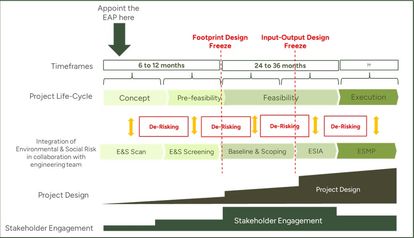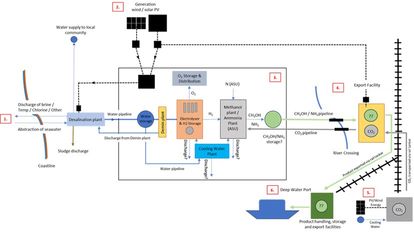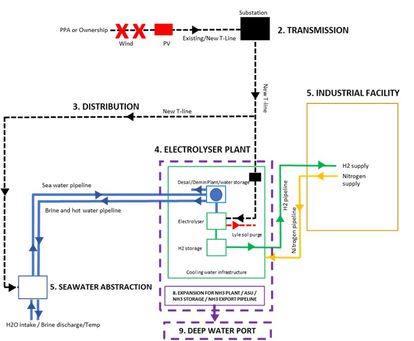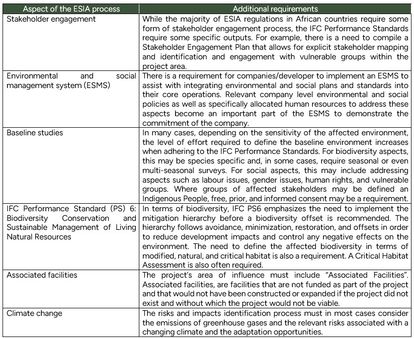
Why social impact must be accounted for like climate and nature
by Clodagh Connolly, Nicola Inge, Andres Schottlaender
View post

Since compiling our earlier briefing note on the Challenges of Permitting Green Hydrogen and Ammonia Projects in South Africa, SLR has for the last few years been involved in advising on several green hydrogen and ammonia (GH2) export projects across Africa. Based on this experience, SLR provided input into the soon to be published guidelines: Managing the Impacts of a Green Hydrogen/Power-to-X Economy: An Environmental Assessment Guideline for South Africa, a project funded by the Deutsche Gesellschaft für Internationale Zusammenarbeit (GIZ) and coordinated in collaboration between GFA Consulting Group GmbH (GFA) and the CSIR (Schreiner, G et al 2024 in press).
The discussion below provides a summary of SLR’s inputs included in the above-mentioned guideline document and focusses on some of the key lessons we have learnt over the past few years, with regards to managing environmental and social risks of GH2 export projects in Africa.
Several governments across Africa have communicated their ambitious aspirations regarding the development of GH2 projects in their respective countries. In South Africa, the Northern Cape Green Hydrogen Strategy was announced in 2021 at COP26 [1]. A master plan for a green hydrogen Special Economic Zone is being developed, which aims to support 40GW of electrolyser capacity by 2050.
While in Namibia, the Southern Corridor Development Initiative plans for a potential of 30GW of green hydrogen within an area of 14,000 km2. Hyphen Hydrogen Energy has been awarded preferred bidder status on approximately 4,000 km2 of this land within the Tsau /Khaeb National Park [2]. The Hyphen project is estimated to cost US$10 billion, targeting the production of 350 000 tons of green hydrogen production a year from approximately 7GW of renewable generation.
In Mauritania, several companies have signed Memorandums of Understanding (MoUs) with the Government of Mauritania to produce green hydrogen [3]. CWP Global has signed an MoU for the development of a US$40 billion GH2 project situated in a 8,500 km2 site in the country’s northern desert and coastal regions of Dakhlet Nouadhibou and Inchiri. The project will be made up of 30GW of renewable energy and is expected to produce 1.7 million tons of green hydrogen and 10 million tons of green ammonia. Chariot has signed a similar MoU with the Mauritanian Government for the development of a 10GW project spread over an onshore and offshore area of about 5,000 km2. The project aims to produce 1.2million tons of green hydrogen by 2030. Morrocco and Egypt have similar aspirations, aiming for the development of several GW of renewable energy, over thousands of square kilometres for the production of millions of tons of green hydrogen and ammonia.
When considering the size and complexity of individual projects within the context of the broader strategies and aspirations of each country, the potential significant cumulative environmental and social impacts become apparent. Planning common infrastructure (desalination, transmission, roads and port facilities) for multiple GH2 projects in the same area is one of the more obvious challenges. The need for Strategic Environmental Assessments of these green hydrogen policies, plans and road maps requires urgent attention if the cumulative impacts of GH2 projects are to be considered and these projects developed with long-term sustainability as their aim. The global transition to net zero could easily result in a flip from a global climate change crisis to a global biodiversity crisis.
When focussing on individual projects, the first lessons is simply to note the scale and complexity of GH2 export projects. When SLR started to engage our clients in Africa, it soon became apparent that very few of the technical, financial or environmental teams fully grasped the scale and complexity of these projects. The infrastructure requirements for GH2 projects are large and complex, and the footprint can be spread over several thousands of square kilometres. This results in infrastructure being located in very different receiving environments (onshore, coastal and marine) where very different biodiversity and social impacts are likely to occur. Understanding the spatial scale of the project area and the logistical challenges this presents for both the technical and environmental design and planning is critical. This combined with the complexity of project infrastructure (which can include wind, PV, transmission lines, roads, water supply and hydrogen/ammonia pipelines, desalination plant, electrolyser, ammonia production plant, hydrogen and ammonia storage, ammonia transport, and associated export port facilities, construction village, borrowpits/quarries etc) requires that project teams “think big”, “think differently” and push the boundaries of project development. It also requires rethinking some of the standard biodiversity baseline methodologies that were not designed with projects of this scale in mind.
Biodiversity and social baseline methodologies need to be carefully planned to accommodate the scale and diversity of the project. Standard baseline methodologies were not designed with projects of this scale in mind and may therefore not apply. Implementing the mitigation hierarchy at this scale of project area requires careful integration between the technical and environmental teams.
Typically, developers will engage Environmental Assessment Practitioners (EAPs) at the stage when an Environmental and Social Impact Assessment (ESIA) and associated permits are required, this being mostly well into the project development. For projects of this scale and complexity, engaging an EAP at this later stage is simply too late. Critical to the success of these mega projects is the proactive identification of potential environmental and social constraints that may impact on project development such as project infrastructure placement and layout. The avoidance of sensitive biodiversity areas and culturally important sites is the first step in applying the mitigation hierarchy.
Developers should engage an EAP to work collaboratively with the technical and financial teams at the earliest stages of project planning and de-risking (see Figure 1). This will allow the EAP to develop a full appreciation of the complexity and scale of the project and to work with the technical and financial teams to de-risk the project from an environmental and social perspective. This will also enable the EAP to provide more accurate cost and schedule estimates for the ESIA and other environmental permitting that will be required at a later stage.
As part of the de-risking work and planning for permitting, the EAP should work with the developer to understand the socioeconomic contexts of the affected stakeholders, both local and global. This stakeholder analysis should be used to develop a robust Stakeholder Engagement Plan for the ESIA, to be led by the EAP, and a Project Communication Plan to be led by the developer.

A GH2 export project consist of many different project components, including most, if not all of the following:
The infrastrcture requirements (water supply, construction village, laydown areas, port facilities, roads etc) to support the construction phase of a GH2 export project in a remote arid environment could be significant. In many cases the impacts of these types of projects are at their highest during construction.
Each of these project components has a potentially different impact on the affected marine and terrestrial environment with the spatial extent of the project components adding additional complexity. Certain project components may require very specific seasonal baseline data gathering, for example bird and bat movements within a wind farm area and marine water quality for the abstraction points and brine discharge areas for the desalination plant.
The complexity of the project, combined with the complexity of the affected environment over very large areas (sometime several thousands of square kilometres) requires sufficient time to process and understand. By gaining a thorough understanding of the project and affected environment the EAP can firstly assist with de-risking the project and secondly understanding the level of effort required to undertake the baseline studies, the stakeholder engagement and finally the compilation of the ESIA and Environmental and Social Management Plans (ESMP) reports.
When an EAP has been appointed at the concept/pre-feasibility phase of the project to work alongside the technical and financial teams, the first task of the EAP should be to understand the various project components, the footprint (spatial extent) and inputs/outputs of each component. To do this, it is often advantageous to compile a simple non-technical flow or block diagram showing the main project components and how they are linked. Examples of these are shown in Figure 2 and 3.


Due to the complexities of a GH2 project, it is advisable to unpack and understand all of the required inputs and outputs when compiling the project description. For example, start with the power generation components and then systematically describe the project and its various components up to the export of ammonia at the end of the process. Also consider infrastructure required for the construction phase as this can be significant. For example, the construction phase could attract many thousands of construction workers which may require the construction of a small town with accommodation and recreational areas, power supply, water supply, wastewater treatment, waste management and various other services prior to construction starting. Water supply during construction is another key consideration, especially in arid environments where several GH2 projects are proposed, and could involve significant infrastructure and associated impacts.
Renewable energy projects are usually financed by third party international banks, lenders and investors who may subscribe to the Equator Principles and International Finance Corporation (IFC) Performance Standards. GH2 export projects are likely to use a funding structure which relies, at least for some infrastructure, on project financing. ESIAs required for such project finance will need to be aligned with both the host country ESIA regulations as well as international lender requirements. Different financial institutions have different sustainability requirements, but typically most banks or lenders will use the Equator Principles and IFC Performance Standards to identify and manage environmental and social risks for their investment.
While some ESIA process in Africa are aligned to some degree with the ESIA process requirements of the IFC Performance Standards, there are often a number of aspects that demand more attention and more detailed inputs than required by the host country ESIA regulations. Table 1 provides some examples of the additional inputs that may be required. This is not an exhaustive list and ultimately the EAP will need to thoroughly review the IFC Performance Standards and the host country ESIA regulatory requirements, identify the overlaps and gaps between the two and plan to address these.

Another important consideration that may influence the number and types of separate ESIA applications is the finance structure of the entire project. If the GH2 export project is being financed as a single Special Purpose Vehicle (SPV), then a single ESIA for all project components may be required. However, if some of the project components, such as the transmission lines and/or the generation components will be owned by third parties, then multiple ESIA applications may be required. Unpacking this at the earliest stages of the project planning will be important.
The scale and complexity of GH2 export projects demands a very different approach and relationship between the developer and the EAP. A close integrative working relationship between the technical, financial, and environmental workstreams is required from the earliest phases of the project lifecycle. Proactive identification of environmental and social constraints and risks is required with an understanding of the logistical challenges of undertaking this across a project area of several thousands of square kilometres. Understanding that infrastructure will be located in very different receiving environments where very different biodiversity and social impacts could occur is important. Unpacking the links between all project components at the start of the project and understanding the spatial footprint of all project components is essential. Managing the environmental and social risks within the context of the host country’s ESIA regulations is not sufficient, and consideration must be given to the requirements of international lenders.
To speak to our experts about your own project, please get in touch.
-------------------------------------------
Lead author: Stuart Heather-Clark
Contributing authors: Stephan van den Berg, Eloise Costandius, Jeremy Blood, Jessica Hughes, Sue Reuther.
--------------------------------------------
References
3 - https://gh2.org/countries/mauritania
4 - Schreiner, G., Snyman-van der Walt, L., Heather-Clark, S., Van den Berg, S., Strong, A., Claasen, L., Russo, V., Mqokeli, B., & De Wet, B. (2024) Managing the Impacts of a Green Hydrogen/Power-to-X Economy: An Environmental Assessment Guideline for South Africa. CSIR: Stellenbosch. CSIR/SPLA/SECO/IR/2024/0005/B